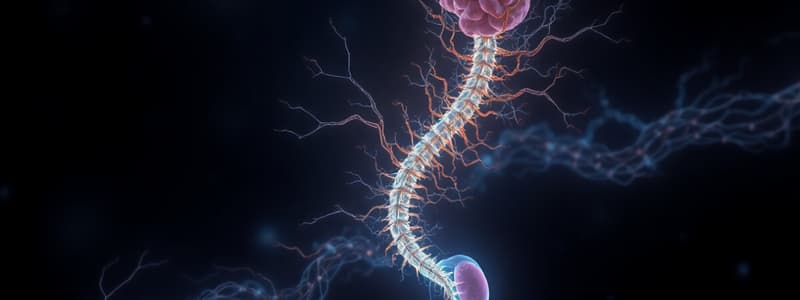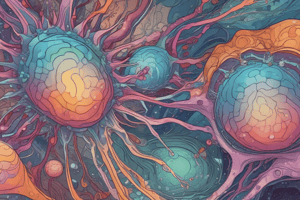Podcast
Questions and Answers
What type of cells give rise to the neurons and macroglial cells in the spinal cord?
What type of cells give rise to the neurons and macroglial cells in the spinal cord?
- Adipocytes
- Ependymal cells
- Microglial cells
- Neuroepithelial cells (correct)
What structure separates the dorsal part (alar plate) from the ventral part (basal plate) in the developing spinal cord?
What structure separates the dorsal part (alar plate) from the ventral part (basal plate) in the developing spinal cord?
- Ependyma
- Ventral median fissure
- Dorsal median septum
- Sulcus limitans (correct)
Which of the following cells differentiate into ependymal cells that line the central canal of the spinal cord?
Which of the following cells differentiate into ependymal cells that line the central canal of the spinal cord?
- Neural crest cells
- Neuroblasts
- Neuroepithelial cells (correct)
- Glioblasts
The unipolar neurons in the spinal ganglia are derived from which type of cells?
The unipolar neurons in the spinal ganglia are derived from which type of cells?
Which layer of the developing spinal cord becomes recognizable as the outer parts of the neuroepithelial cells?
Which layer of the developing spinal cord becomes recognizable as the outer parts of the neuroepithelial cells?
What characterizes spina bifida occulta?
What characterizes spina bifida occulta?
What results from the failure of the vertebral arches to close?
What results from the failure of the vertebral arches to close?
What are the secondary brain vesicles derived from the forebrain?
What are the secondary brain vesicles derived from the forebrain?
Which flexure occurs between the brain and the spinal cord?
Which flexure occurs between the brain and the spinal cord?
How many primary brain vesicles are formed during the early development of the brain?
How many primary brain vesicles are formed during the early development of the brain?
What condition denotes a serious neural tube defect with an open spinal cord?
What condition denotes a serious neural tube defect with an open spinal cord?
Which part of the brain does not divide into further secondary vesicles?
Which part of the brain does not divide into further secondary vesicles?
What structure does the myelencephalon develop into?
What structure does the myelencephalon develop into?
Which area of the brain is affected by the pontine flexure during its development?
Which area of the brain is affected by the pontine flexure during its development?
What shape does the cavity of the myelencephalon take during development?
What shape does the cavity of the myelencephalon take during development?
Which structure forms from the metencephalon?
Which structure forms from the metencephalon?
What is the role of the archicerebellum?
What is the role of the archicerebellum?
Neuroblasts from which plates migrate to form the gracile and cuneate nuclei?
Neuroblasts from which plates migrate to form the gracile and cuneate nuclei?
Which part of the cerebellum is primarily associated with sensory data from the limbs?
Which part of the cerebellum is primarily associated with sensory data from the limbs?
What happens to the lateral walls of the pons due to the pontine flexure?
What happens to the lateral walls of the pons due to the pontine flexure?
Which part of the brain carries descending corticospinal fibers?
Which part of the brain carries descending corticospinal fibers?
What is the primary role of the pons in the brainstem?
What is the primary role of the pons in the brainstem?
Which structure in the midbrain is primarily associated with the processing of auditory information?
Which structure in the midbrain is primarily associated with the processing of auditory information?
What percentage of the brain's total neurons does the cerebellum contain?
What percentage of the brain's total neurons does the cerebellum contain?
Which part of the brain is responsible for motor coordination, proprioception, and balance?
Which part of the brain is responsible for motor coordination, proprioception, and balance?
The lateral ventricles are formed from the cavities of which brain structure?
The lateral ventricles are formed from the cavities of which brain structure?
During what week of development do the telencephalic vesicles arise?
During what week of development do the telencephalic vesicles arise?
The foramen interventriculare is a connection between which two structures?
The foramen interventriculare is a connection between which two structures?
What is the primary characteristic of the substantia nigra in the midbrain?
What is the primary characteristic of the substantia nigra in the midbrain?
The anterior part of the forebrain is known as which of the following?
The anterior part of the forebrain is known as which of the following?
Flashcards
Neuroepithelial cells
Neuroepithelial cells
Cells that form the initial wall of the neural tube and give rise to neurons and macroglial cells in the spinal cord.
Ventricular Zone
Ventricular Zone
The innermost layer of the neural tube, composed of neuroepithelial cells, and the source of neurons and macroglia.
Marginal Zone (White Matter)
Marginal Zone (White Matter)
The outer layer of the neural tube, which becomes the white matter of the spinal cord, formed by axons migrating into it.
Mantle Layer (Gray Matter)
Mantle Layer (Gray Matter)
Signup and view all the flashcards
Neuroblasts
Neuroblasts
Signup and view all the flashcards
Glioblasts
Glioblasts
Signup and view all the flashcards
Ependymal Cells
Ependymal Cells
Signup and view all the flashcards
Sulcus Limitans
Sulcus Limitans
Signup and view all the flashcards
Alar Plate
Alar Plate
Signup and view all the flashcards
Basal Plate
Basal Plate
Signup and view all the flashcards
Spinal Ganglia
Spinal Ganglia
Signup and view all the flashcards
Neural Crest Cells
Neural Crest Cells
Signup and view all the flashcards
Spina Bifida Occulta
Spina Bifida Occulta
Signup and view all the flashcards
Spinal Dermal Sinus
Spinal Dermal Sinus
Signup and view all the flashcards
Spina Bifida Cystica
Spina Bifida Cystica
Signup and view all the flashcards
Meningocele
Meningocele
Signup and view all the flashcards
Meningomyelocele
Meningomyelocele
Signup and view all the flashcards
Myeloschisis
Myeloschisis
Signup and view all the flashcards
Neural Tube
Neural Tube
Signup and view all the flashcards
Primary Brain Vesicles
Primary Brain Vesicles
Signup and view all the flashcards
Telencephalon
Telencephalon
Signup and view all the flashcards
Diencephalon
Diencephalon
Signup and view all the flashcards
Metencephalon
Metencephalon
Signup and view all the flashcards
Myelencephalon
Myelencephalon
Signup and view all the flashcards
Cervical Flexure
Cervical Flexure
Signup and view all the flashcards
Cephalic Flexure
Cephalic Flexure
Signup and view all the flashcards
Pontine Flexure
Pontine Flexure
Signup and view all the flashcards
Pontine Flexure
Pontine Flexure
Signup and view all the flashcards
Myelencephalon
Myelencephalon
Signup and view all the flashcards
Metencephalon
Metencephalon
Signup and view all the flashcards
Medulla Oblongata
Medulla Oblongata
Signup and view all the flashcards
Fourth Ventricle
Fourth Ventricle
Signup and view all the flashcards
Gracile Nuclei
Gracile Nuclei
Signup and view all the flashcards
Cuneate Nuclei
Cuneate Nuclei
Signup and view all the flashcards
Corticospinal Fibers
Corticospinal Fibers
Signup and view all the flashcards
Cerebellum
Cerebellum
Signup and view all the flashcards
Archicerebellum
Archicerebellum
Signup and view all the flashcards
Paleocerebellum
Paleocerebellum
Signup and view all the flashcards
Neocerebellum
Neocerebellum
Signup and view all the flashcards
Cerebellum
Cerebellum
Signup and view all the flashcards
Pons
Pons
Signup and view all the flashcards
Midbrain (Mesencephalon)
Midbrain (Mesencephalon)
Signup and view all the flashcards
Cerebral Aqueduct
Cerebral Aqueduct
Signup and view all the flashcards
Colliculi (Superior & Inferior)
Colliculi (Superior & Inferior)
Signup and view all the flashcards
Substantia Nigra
Substantia Nigra
Signup and view all the flashcards
Crus Cerebri
Crus Cerebri
Signup and view all the flashcards
Telencephalon
Telencephalon
Signup and view all the flashcards
Diencephalon
Diencephalon
Signup and view all the flashcards
Lateral Ventricles
Lateral Ventricles
Signup and view all the flashcards
Optic Vesicles
Optic Vesicles
Signup and view all the flashcards
Foramen of Monro
Foramen of Monro
Signup and view all the flashcards
Study Notes
Spinal Cord Development
- Neuroepithelial cells give rise to neurons and macroglial cells in the spinal cord.
- The sulcus limitans separates the alar plate (dorsal part) from the basal plate (ventral part) in the developing spinal cord.
- Neuroepithelial cells differentiate into ependymal cells that line the central canal of the spinal cord.
- Unipolar neurons in the spinal ganglia are derived from neural crest cells.
- The marginal layer of the developing spinal cord becomes recognizable as the outer parts of the neuroepithelial cells.
- Spina bifida occulta is characterized by a gap in one or more vertebrae, but the spinal cord remains covered by skin.
- The failure of the vertebral arches to close results in spina bifida, a birth defect that can range in severity.
Brain Development
- The forebrain (prosencephalon) divides into the telencephalon and diencephalon as secondary brain vesicles.
- The pontine flexure occurs between the brain and the spinal cord.
- There are three primary brain vesicles formed during the early development of the brain: prosencephalon, mesencephalon, and rhombencephalon.
- Anencephaly denotes a serious neural tube defect with an open spinal cord.
- The mesencephalon does not divide into further secondary vesicles.
- The myelencephalon develops into the medulla oblongata.
- The pontine flexure affects the pons during its development.
- The cavity of the myelencephalon takes a diamond shape during development.
- The metencephalon forms the pons and cerebellum.
Cerebellum Development
- The archicerebellum is responsible for balance, muscle tone, and posture.
- Neuroblasts from the alar plate migrate to form the gracile and cuneate nuclei.
- The spinocerebellum is primarily associated with sensory data from the limbs.
- The lateral walls of the pons flatten due to the pontine flexure.
Brainstem Development
- The pons carries descending corticospinal fibers that control voluntary movement.
- The pons plays a key role in relaying information between the cerebrum and cerebellum.
- The inferior colliculus in the midbrain is primarily associated with the processing of auditory information.
Cerebellum
- The cerebellum contains approximately 80% of the brain's total neurons.
- It is responsible for motor coordination, proprioception, and balance.
Telencephalon Development
- The lateral ventricles are formed from the cavities of the telencephalon.
- The telencephalic vesicles arise during the fifth week of development.
- The foramen interventriculare connects the lateral ventricles and the third ventricle.
Midbrain
- The substantia nigra in the midbrain is characterized by dark pigmentation due to the presence of melanin.
- The telencephalon, or cerebrum, is the anterior part of the forebrain.
Studying That Suits You
Use AI to generate personalized quizzes and flashcards to suit your learning preferences.




